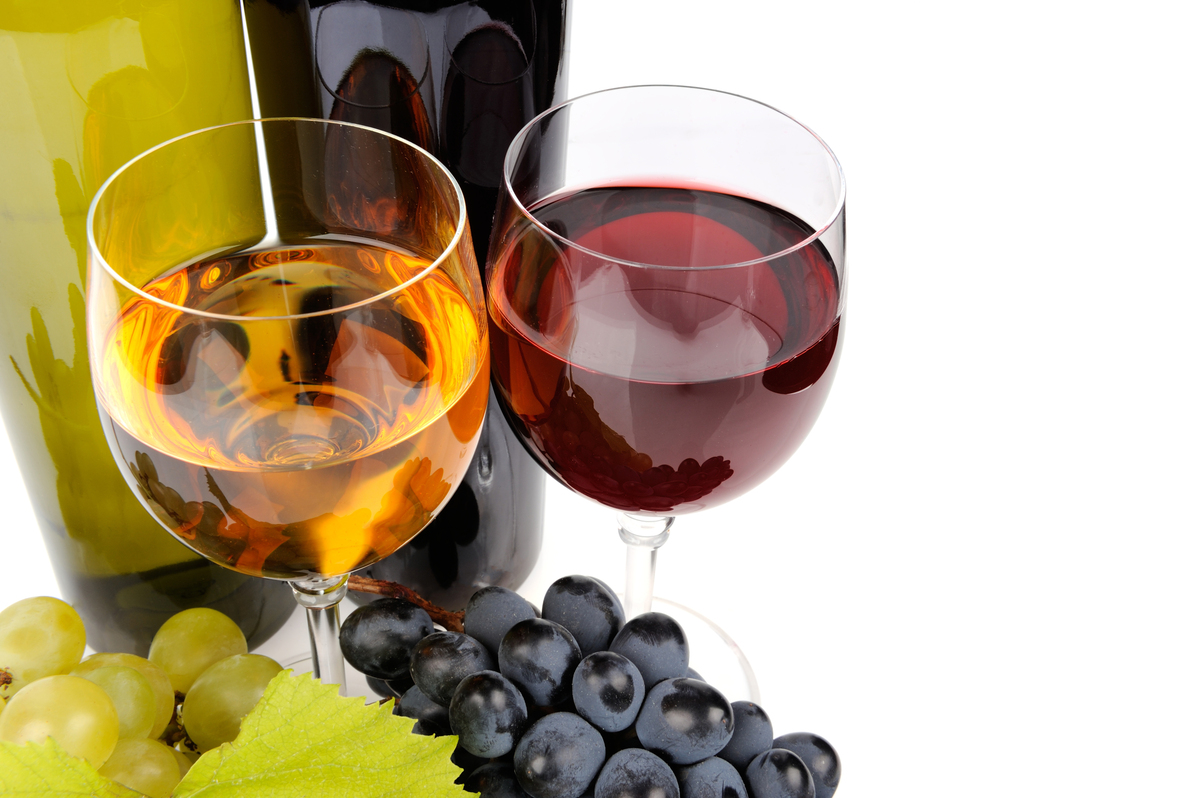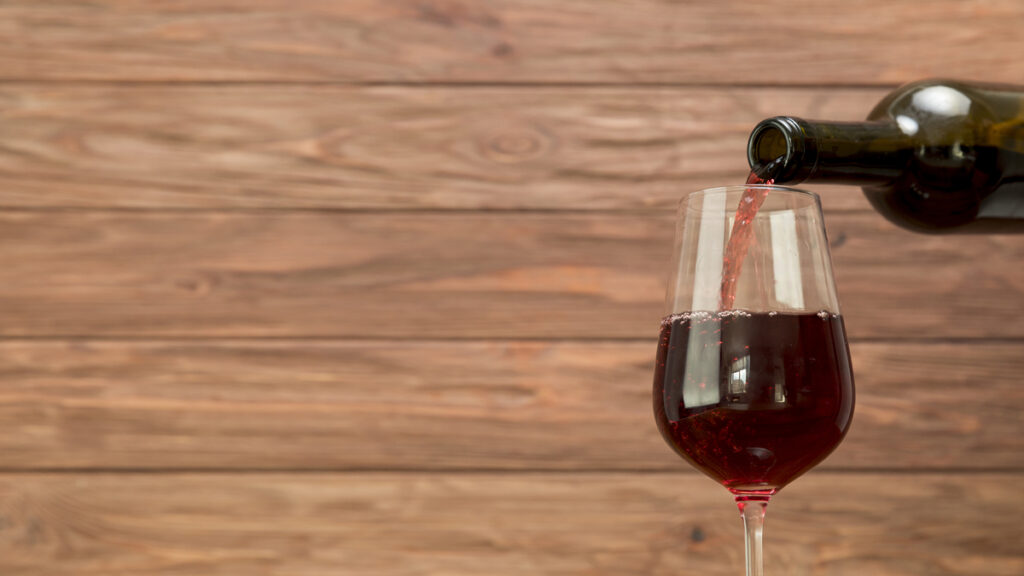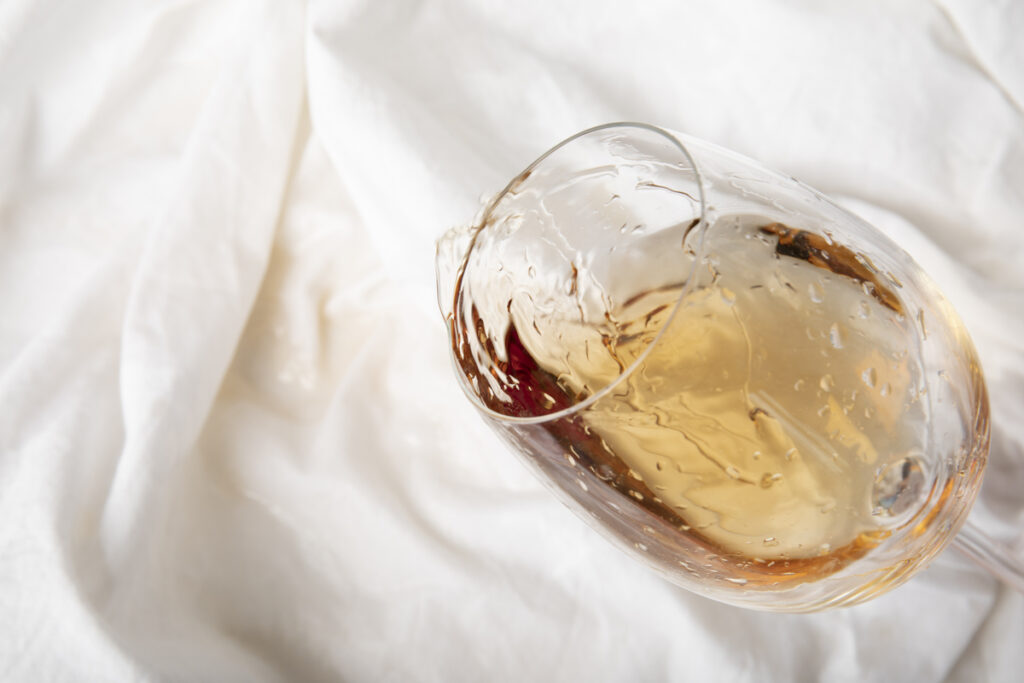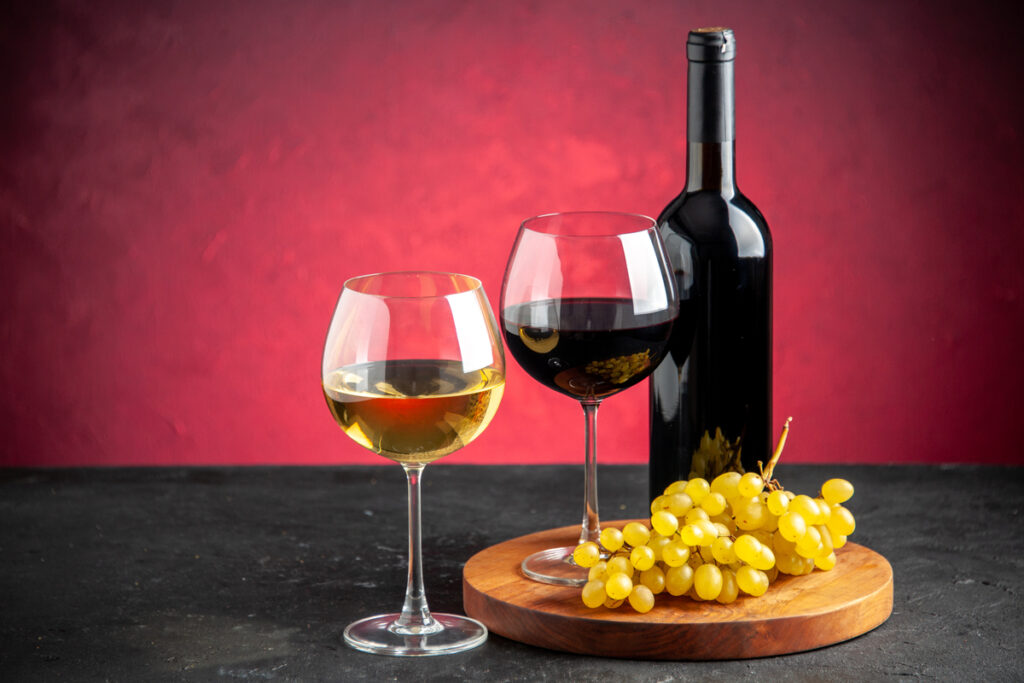
The world of wine offers a vast array of flavors and experiences. But for beginners, a fundamental question often arises: red wine or white wine? This guide dives into the characteristics, varieties, and food pairings of both red and white wines, helping you navigate this exciting world and discover your perfect choice.
Unveiling the Differences
Grape Origins and Processing
Red Wine: Made from dark-skinned grapes like Cabernet Sauvignon, Merlot, Shiraz/Syrah, Zinfandel, Pinot Noir, and Gamay. The color pigments (anthocyanins) reside in the skins, and when these skins are left in contact with the juice during fermentation, they impart color, tannins, and flavor compounds to the wine. Tannins are natural antioxidants found in grape skins, seeds, and stems. They contribute to the astringency or drying sensation felt on the palate, which can be perceived as bitterness or puckering. The length of skin contact significantly impacts the final product. For example, lighter-bodied red wines like Pinot Noir typically have shorter skin contact compared to full-bodied Cabernet Sauvignon, resulting in less intense color and smoother tannins.
White Wine: Made from white or green grapes like Chardonnay, Sauvignon Blanc, Pinot Grigio/Pinot Gris, Riesling, and Moscato. Although the grape skin color can range from pale green to yellow-gold, it has minimal impact on the final color of the wine. In white wine production, the grapes are pressed to separate the juice (must) from the skins, seeds, and stems early on in the process. This minimizes the extraction of color and tannins, leading to lighter-bodied wines with a focus on the fresh fruit characteristics of the grape variety.
Color Spectrum
Red Wine: The color spectrum of red wine can range from a light ruby red (think Pinot Noir) to a deep, inky purple (think Cabernet Sauvignon). Factors influencing the color include:
- Grape Variety: Different grape varieties have varying levels of anthocyanins, leading to inherent color differences. For example, Cabernet Sauvignon grapes are naturally high in anthocyanins, resulting in deep-colored wines, while Pinot Noir grapes have lower anthocyanin content, producing lighter-bodied wines with a ruby hue.
- Aging: As red wines age, the color can evolve. Young red wines might appear more vibrant and purple-toned, while mature wines can develop a more brick-red or brownish color.
White Wine: White wines typically range in color from pale yellow to golden yellow, with some variations depending on the grape variety and production methods. Factors influencing the color include:
- Grape Variety: Some white grapes, like Chardonnay, can have a slightly greenish tinge due to chlorophyll pigments in the skin. However, these pigments are usually minimal and don’t significantly impact the final color.
- Skin Contact: Even in white wine production, there can be minimal skin contact during pressing. This brief contact can introduce slight phenolic compounds that contribute to a deeper golden hue.
- Skin Type: Some white grapes, like those used for some orange wines, have thicker skins with more color pigments. Limited skin contact with these grapes can result in a more golden or even orange-tinted wine.
- Oak Aging: White wines aged in oak barrels can develop a deeper golden color due to the extraction of compounds from the wood.
Flavor Profiles
Red Wine: Red wines are known for their bold and complex flavor profiles. The primary flavor contributors include:
- Fruit Notes: Depending on the grape variety, red wines can exhibit a spectrum of fruit flavors, including berry (raspberry, blackberry, blueberry), plum, cherry, and currant.
- Spice Notes: Red wines can have hints of pepper, clove, cinnamon, and allspice, particularly those aged in oak barrels.
- Herbal Notes: Some red wines, especially those from cooler climates, might display notes of herbs like mint, eucalyptus, or thyme.
- Earthy Notes: Earthy notes can range from mushroom and forest floor to barnyard and leather. These can be more prominent in certain red wine varieties like Cabernet Sauvignon and Pinot Noir.
- Tannins: As mentioned earlier, tannins contribute to the drying sensation on the palate and can add complexity to the flavor profile. Young red wines might have more prominent tannins, which can soften and become smoother with aging.
White Wine: White wines are generally lighter and more refreshing than red wines. Their flavor profiles are typically driven by:
- Fruit Notes: Similar to red wines, white wines showcase a variety of fruit flavors depending on the grape variety. Common notes include citrus (lemon, lime, grapefruit), stone fruit (peach, apricot, nectarine), tropical fruit (pineapple, mango), and green apple.
- Floral Notes: White wines can have delicate floral aromas like jasmine, honeysuckle, and rose. These are particularly noticeable in some aromatic varieties like Sauvignon Blanc and Gewürztraminer.
- Mineral Notes: Depending on the soil composition where the grapes are grown, white wines can exhibit mineral notes like flint, wet stone, or even a slight salinity. These can add complexity and intrigue to the overall flavor profile.
- Acidity: Acidity is a crucial component of white wines, contributing to their crispness, freshness, and balance. It helps to cut through richness and can also enhance the perception of fruit flavors. Grape variety and winemaking techniques significantly influence the level of acidity in a white wine. For example, Sauvignon Blanc is known for its high acidity, while Chardonnay can vary depending on factors like climate and aging methods.
- Oak Influence: While less prominent than in red wines, some white wines are aged in oak barrels. This imparts additional flavor characteristics like vanilla, toast, butter, and baking spices, adding complexity and richness to the wine. Unoaked white wines, on the other hand, will showcase the pure fruit character of the grape variety.
Body and Texture
Red Wine: Red wines can range from light-bodied to full-bodied, impacting their mouthfeel and weight.
- Light-bodied Red Wines: These wines, like Pinot Noir or Gamay, have a lighter texture and are higher in acidity. They are often described as refreshing and easy to drink.
- Medium-bodied Red Wines: Wines like Merlot or Shiraz/Syrah fall into this category. They offer a more substantial mouthfeel than light-bodied reds but are not as weighty as full-bodied styles.
- Full-bodied Red Wines: Cabernet Sauvignon is a prime example of a full-bodied red wine. These wines have a bold, powerful mouthfeel with high tannins and alcohol content. They can be quite age-worthy, developing smoother tannins and more complex flavors over time.
White Wine: White wines are typically lighter-bodied than red wines due to the minimal extraction of tannins from the skins. However, there can be variations within white wines:
- Light-bodied White Wines: These wines, like Pinot Grigio or Sauvignon Blanc, are known for their crispness and refreshing acidity. They are perfect for warm weather or as an apéritif.
- Medium-bodied White Wines: Chardonnay is a good example of a medium-bodied white wine. Depending on the winemaking style (oaked vs. unoaked), these wines can offer a richer texture with more weight on the palate compared to light-bodied styles.
- Full-bodied White Wines: While less common, some white wines, particularly those aged extensively in oak barrels or with residual sugar, can have a fuller body. These wines might exhibit a richer texture and higher alcohol content.
Exploring the World of Red Wines
Major Red Wine Varieties
Cabernet Sauvignon: The “King of Red Grapes,” known for its full-bodied structure, bold tannins, and intense flavors. Common characteristics include:
- Flavor Profile: Black currant, blackberry, cassis (blackcurrant bud), cedar, tobacco, leather, and hints of bell pepper (especially in cooler climates).
- Aroma: Similar to the flavor profile, with additional notes of dark chocolate and violets.
- Food Pairing: Pairs well with rich and bold flavors due to its full body and tannins. Consider red meat (steak, lamb), roasted vegetables, hearty stews, and aged cheeses.
- Aging Potential: Cabernet Sauvignon is known for its excellent aging potential. As the wine matures, the tannins soften, and the flavors become more complex and integrated. Young Cabernet Sauvignon can be quite astringent, but with aging, it develops smoother tannins and reveals layers of flavor.
Merlot: Often described as the “softer” cousin of Cabernet Sauvignon, Merlot offers a more approachable style with smoother tannins and fruit-forward flavors. Common characteristics include:
- Flavor Profile: Plum, cherry, blackcurrant, raspberry, chocolate, and sometimes herbal notes.
- Aroma: Similar to the flavor profile, with additional notes of plum and cedar.
- Food Pairing: Merlot’s versatility makes it a popular choice for food pairing. It complements grilled meats (burgers, steaks), pasta dishes (meat sauces, lasagna), and even lighter fare like roasted chicken.
- Aging Potential: While Merlot can be enjoyed young, it also benefits from some bottle aging, allowing the tannins to soften and the flavors to develop further. However, it typically doesn’t have the same extended aging potential as Cabernet Sauvignon.
Pinot Noir: A lighter-bodied and elegant red wine known for its delicate fruit character and high acidity. Common characteristics include:
- Flavor Profile: Raspberry, strawberry, cherry, plum, earth (often described as “forest floor” or “mushroom”), and sometimes floral notes.
- Aroma: Similar to the flavor profile, with pronounced aromas of red fruit and sometimes hints of spice and earth.
- Food Pairing: Due to its lighter body and high acidity, Pinot Noir pairs well with lighter proteins like poultry (chicken, duck), salmon, and even some vegetarian dishes like mushroom risotto.
- Aging Potential: Pinot Noir typically benefits from shorter aging compared to Cabernet Sauvignon or Merlot. While some age-worthy examples exist, most Pinot Noirs are best enjoyed within a few years of bottling, as the delicate fruit character can diminish with extended aging.
Shiraz/Syrah: This grape variety offers a spectrum of styles depending on the region. In the Rhône Valley of France, Syrah produces wines with a peppery character, black fruit flavors, and a savory profile. In warmer climates like Australia, Shiraz is known for its full-bodied style, bold fruit notes (blackberry, plum), and peppery spice. Common characteristics include:
- Flavor Profile: (Depending on region) Black fruit (blackberry, plum), black pepper, spice, earth, smoke, leather (in some cases).
- Aroma: Similar to the flavor profile, with additional notes of violets and meatiness (especially in Rhône Syrah).
- Food Pairing: Shiraz/Syrah’s bold flavors make it a great match for rich and flavorful dishes. Think grilled meats (steak, lamb), stews, hearty pastas, and spicy food.
- Aging Potential: The aging potential of Shiraz/Syrah varies depending on the region and style. Australian Shiraz can be enjoyed young but can also benefit from some aging. Rhône Syrah, particularly from the northern part of the region, often benefits from longer cellaring to soften tannins and develop more complex flavors.
Zinfandel: This versatile grape can produce a range of styles, from lighter-bodied and fruity rosés to full-bodied and robust red wines. In California, Zinfandel is known for its bold fruit flavors and slightly spicy character. Common characteristics include:
- Flavor Profile: Blackberry, raspberry, plum, spice (white pepper, clove), jammy or ripe fruit notes (depending on ripeness at harvest).
- Aroma: Similar to the flavor profile, with additional notes of blueberry and floral characteristics.
- Food Pairing: Zinfandel’s bold fruit character makes it a good match for flavorful dishes like BBQ fare (ribs, pulled pork), pasta with tomato sauce, and burgers.
- Aging Potential: While some Zinfandels can benefit from a few years of aging, most are best enjoyed young to retain their vibrant fruit flavors.
Delving into the World of White Wines
Major White Wine Varieties
Chardonnay: One of the most popular white wine grapes globally, Chardonnay offers a wide range of styles depending on factors like climate, grape ripeness, and winemaking techniques. Here’s a breakdown of some common styles:
- Unoaked Chardonnay: Unoaked Chardonnay showcases the pure fruit character of the grape, often displaying flavors of green apple, pear, citrus (lemon, grapefruit), and sometimes tropical fruit (pineapple, mango) in warmer climates. Unoaked Chardonnay can also have a crisp and refreshing acidity, making it a versatile food pairing option.
- Oaked Chardonnay: Chardonnay aged in oak barrels develops additional flavor characteristics beyond the pure fruitiness. Depending on the type of oak used (American vs. French) and the length of aging, oaked Chardonnay can exhibit flavors of vanilla, toast, butter, baking spices, and even honey. These oaked styles tend to have a richer mouthfeel and lower acidity compared to unoaked Chardonnay.
- Full-bodied Chardonnay: Wines produced from grapes grown in warmer climates or those that undergo malolactic fermentation (a process that converts some malic acid to softer lactic acid) can result in a fuller-bodied Chardonnay. These wines might have a richer texture, lower acidity, and more prominent oak influence compared to lighter-bodied styles.
Sauvignon Blanc: A widely-recognized white wine grape known for its crisp acidity and pronounced citrusy aromas and flavors. Common characteristics include:
- Flavor Profile: Grapefruit, lemon, lime, gooseberry, passion fruit (in some cases), and sometimes herbal notes like grassy or asparagus.
- Aroma: Similar to the flavor profile, with additional notes of freshly cut grass, cat’s pee (a desirable aroma in Sauvignon Blanc, often described as “sauvignon character”), and sometimes tropical fruit notes depending on the region.
- Food Pairing: Sauvignon Blanc’s high acidity makes it a great match for lighter fare like salads, shellfish (oysters, mussels), goat cheese, and even some vegetarian dishes.
Pinot Grigio/Pinot Gris: This grape variety can produce a range of styles depending on the region. In Italy, Pinot Grigio is known for its light-bodied and crisp character with flavors of pear, apple, lemon, and sometimes mineral notes. In Alsace, France, Pinot Gris grapes can be used to produce richer styles with riper fruit characteristics and some texture. Common characteristics include:
- Flavor Profile: (Depending on region) Pear, apple, lemon, citrus, melon, and sometimes floral notes.
- Aroma: Similar to the flavor profile, with additional notes of honeysuckle and minerality.
- Food Pairing: Pinot Grigio’s light and crisp style makes it a versatile option for appetizers, light pasta dishes (seafood, cream sauce), and even grilled chicken.
Riesling: This versatile grape variety produces a spectrum of styles, ranging from bone-dry to very sweet. Riesling is also known for its pronounced acidity and minerality, reflecting the terroir (soils and climate) where the grapes are grown. Common characteristics include:
- Flavor Profile: (Depending on sweetness level) Apple, pear, peach, apricot, lime, honey, minerality (wet stone, flint), and sometimes floral notes.
- Aroma: Similar to the flavor profile, with additional notes of petrol (a desirable aroma in some Rieslings) and honeysuckle.
- Food Pairing: Due to its versatility in sweetness levels, Riesling can pair with a wide range of dishes. Dry Riesling complements spicy food, Asian cuisine, and even some lighter cheeses. Sweeter styles of Riesling can be enjoyed as a dessert wine or paired with richer dishes like foie gras or blue cheese.
Moscato: This aromatic grape variety produces light and sweet wines with low alcohol content. Moscato is known for its pronounced floral and grapey aromas and flavors. Common characteristics include:
- Flavor Profile: Grape, peach, orange blossom, honeysuckle, and sometimes tropical fruit notes.
- Aroma: Intensely aromatic with notes of grape, orange blossom, and other floral characteristics.
- Food Pairing: Moscato’s sweetness makes it a perfect match for appetizers, desserts, or simply enjoyed on its own as a refreshing drink.
Choosing Your Perfect Wine
Considering Your Preferences
Unveiling your personal preferences is the key to navigating the exciting world of wine. Here are some key questions to ask yourself:
- Bold vs. Refreshing: Do you enjoy the intensity and structure of full-bodied red wines like Cabernet Sauvignon or Shiraz? Or perhaps you prefer the lighter and more refreshing character of white wines like Sauvignon Blanc or Pinot Grigio? Consider the weight and mouthfeel you find most appealing in a beverage.
- Sweet vs. Dry: Wine sweetness levels can range from bone-dry to very sweet. Dry wines have minimal residual sugar, resulting in a crisp and refreshing taste. Sweet wines, on the other hand, retain some unfermented grape sugars, leading to a perceptibly sweeter profile. Explore different styles to discover your preferences. For instance, some white wines like Riesling or Moscato can be quite sweet, while most red wines are dry.
- Food Pairing vs. Solo Sipping: Are you looking for a wine to complement a specific meal or simply enjoy it on its own? Understanding the occasion can help guide your choice. Certain wines pair exceptionally well with specific foods due to their flavor profiles and acidity levels. For example, a bold Cabernet Sauvignon might overpower a delicate fish dish, while a crisp Sauvignon Blanc can enhance the flavors of seafood. On the other hand, if you’re enjoying a glass of wine for relaxation, you can prioritize your personal taste preference without worrying about food pairings.
Exploring Different Price Points
Wine prices are influenced by various factors like grape variety, region, production methods, and brand reputation. Don’t be discouraged by expensive wines on a wine list. Here are some tips for exploring different price points:
- Start modestly: Begin your wine exploration with mid-range options. This allows you to discover a variety of styles without breaking the bank. As you develop your palate and preferences, you can venture into higher-priced wines from acclaimed regions or lesser-known gems.
- Explore “by the glass” options: Many restaurants and wine bars offer wines by the glass. This allows you to taste several styles without committing to a full bottle. Take advantage of these options to experiment and discover what you enjoy.
- Look for value wines: There are many excellent wines available at reasonable prices. Talk to knowledgeable staff at your local wine shop; they can recommend good value options that suit your taste and budget.
Start Simple
Don’t be overwhelmed by extensive wine lists. Here’s how to approach them with confidence:
- Familiar Faces: Look for popular grape varieties like Chardonnay, Sauvignon Blanc, Cabernet Sauvignon, Merlot, and Pinot Noir. These widely planted grapes offer a good starting point for exploring different styles and regions.
- Ask for Recommendations: Don’t hesitate to ask the waitstaff or a knowledgeable wine shop employee for recommendations. Describe the flavors you enjoy and your budget, and they can suggest suitable options based on your preferences.
- Embrace Exploration: The beauty of wine lies in its diversity. Don’t be afraid to try something new. As you experiment with different grape varieties and regions, you’ll gradually refine your taste and discover what truly excites your palate.
Learning Through Tasting
Actively engaging with wine through tastings is an excellent way to develop your knowledge and appreciation. Here are some ways to participate in wine tasting:
- Wine Tastings: Attend public wine-tasting events or those hosted by local wineries. These events provide an opportunity to sample a variety of wines, often accompanied by explanations from winemakers or sommeliers.
- Wine Shop Tastings: Many wine shops offer tasting flights, allowing you to compare and contrast different styles side-by-side. This is a great way to learn about the nuances of various grape varieties and winemaking techniques.
- Visit Local Wineries: Visiting wineries can be a delightful experience. You can tour the facilities, learn about the winemaking process, and most importantly, sample their wines directly. Talking to the winemakers or staff can provide valuable insights into the wines and the region’s unique characteristics.
Conclusion
The world of wine is a vast and exciting landscape, brimming with diverse flavors, styles, and experiences waiting to be explored. This guide has hopefully served as a springboard, equipping you with the foundational knowledge to navigate this captivating realm.
As you embark on your wine journey, remember that the most important aspect is enjoyment. Don’t be intimidated by complex terminology or extensive wine lists. Embrace the spirit of discovery and experimentation. Here are some key takeaways to keep in mind:
- Embrace Your Preferences: Understanding your personal taste for bold flavors, refreshing styles, sweetness levels, and food pairing considerations will guide your choices. Don’t be afraid to experiment and refine your preferences as you explore.
- Explore Different Styles: Venture beyond familiar grape varieties and delve into lesser-known regions. Each wine tells a unique story, reflecting the grape variety, terroir (soils and climate), and winemaking techniques. Embrace the diversity and discover hidden gems.
- Learning Through Tasting: Actively engage with wine through tastings, winery visits, and educational resources. This will enhance your knowledge, refine your palate, and help you identify your favorites.
- Develop Your Wine Vocabulary: While not essential for enjoyment, learning some basic wine terms can enrich your experience. Understanding terms like “tannins,” “acidity,” “mouthfeel,” and “bouquet” can help you articulate your preferences and connect with other wine enthusiasts.
- The Journey is the Destination: The beauty of wine lies in the ongoing exploration and discovery. As you delve deeper, you’ll develop a more nuanced appreciation for the intricate world of wine.
Remember, there are no wrong answers when it comes to enjoying wine. The perfect glass is the one that brings you the most pleasure. So, raise a glass, embrace the journey, and uncork a world of flavor!

















